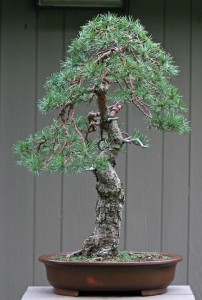Bonsai’s Magical Lure Beckons During Kiku
Posted in Exhibitions, Kiku on October 21 2009, by Plant Talk
Special Display by Yama Ki Society on through November 1
 |
Michael Pollock is Vice-President of Yama Ki Bonsai Society, whose members will display their bonsai in the Enid A. Haupt Conservatory during Kiku in the Japanese Autumn Garden. |
 Bonsai’s beginning is shrouded in the mists of time. With origins in either China or India, bonsai (or penjing in Chinese) found fertile ground when visiting Buddhist monks brought potted trees to Japan. When Japan opened up to the West, interest in bonsai, which means “tray planting,” reignited throughout Asia and began to spread to other parts of the world. As the art form continues to reach new areas, new plants are used to create local bonsai. Whatever the climate, there are plants that can make beautiful bonsai.
Bonsai’s beginning is shrouded in the mists of time. With origins in either China or India, bonsai (or penjing in Chinese) found fertile ground when visiting Buddhist monks brought potted trees to Japan. When Japan opened up to the West, interest in bonsai, which means “tray planting,” reignited throughout Asia and began to spread to other parts of the world. As the art form continues to reach new areas, new plants are used to create local bonsai. Whatever the climate, there are plants that can make beautiful bonsai.
I first studied bonsai in 1982 with Yuji Yoshimura at The New York Botanical Garden. I was immediately captivated by a mixture of feelings these trees elicited from me: tranquility, calmness, excitement. Unfortunately, a busy career prevented me from seriously practicing bonsai then and I gave up. Twelve years ago, I realized that if I could successfully raise children, I could probably grow bonsai, too. It has been a wonderful journey of discovery and creation ever since. Now I grow between 40 and 50 bonsai. In 2004 I won a prestigious “new talent” competition and was awarded a trip to Japan, where I visited many of the most famous bonsai nurseries, growing fields, and public and private collections.
There are many ways to create a bonsai: starting with seeds or cuttings, buying a plant from a nursery (Shanti Bithi Bonsai Nursery in Stamford, Conn, has been an important resource) or collecting a tree from the wild. Of course, for beginners it takes longer to establish an impressive bonsai, but someone with experience can create a “showable” tree within three to five years. Older bonsai plants bring their own stories with them as they are trained, whether it be the twisted and scarred trunks with old, flaky bark or the bonsai practitioners who have cared for the tree over generations, as is witnessed in Japan and China.
Training a bonsai means performing all of the tasks needed to achieve the image of an old tree. Developing the root system to fit in a pot proportionate to the final design, creating aesthetically pleasing branches that are in proportion to the final size of the tree—all this is part of training a tree. The initial stages of a bonsai are the most time consuming. Seasonal tasks such as wiring and pruning can eat up many hours during the vigorous growth of a developing bonsai. Fully wiring a large bonsai can take more than one day. A tree might need to be wired four or five times as it grows until the branches retain the position and shape desired. Once the bonsai has achieved the desired image and its metabolism is slowed by age and the grower’s control of water, fertilizer, and vegetative and root growth, maintaining the tree is less work.
Caring for a “finished” bonsai doesn’t have to be difficult. It needs to be watered when needed–perhaps daily during the hot days of summer. But once your tree has its desired shape, periodic pruning is all that’s needed to keep it looking good.
Come see our trees at this year’s bonsai exhibition during Kiku in the Japanese Autumn Garden. Though other bonsai will be displayed in the Conservatory Courtyards throughout the run of the show, our special bonsai display in the Conservatory will run only through November 1. Members of the Yama Ki Bonsai Society will be on hand to answer your questions, interpret the displays, and give you information on how you can explore this magnificent art.

